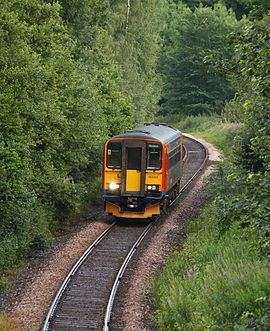Type Heavy rail Status Operational Stations 5 | Opened 1839 | |
 | ||
Derwent valley line community rail day 14 may 2005
The Derwent Valley line is a railway line from Derby to Matlock in Derbyshire.
Contents
- Derwent valley line community rail day 14 may 2005
- Tasrail coal train on the derwent valley line tr16 tr07 at dromedary
- History
- References
The line follows the Midland Main Line as far as Ambergate Junction, which is just south of Ambergate railway station, continuing to Matlock, following the course of the River Derwent.
Local passenger services are operated by East Midlands Trains from Nottingham via Derby to Matlock. Services are approximately hourly Monday to Saturday (with a two-hourly service on Sundays). Two trains per day start/terminate at Derby rather than Nottingham.
The line is operated as one single line block section from Ambergate, using the No Signalman Key Token system under the supervision of Derby PSB. The driver of each train heading for Matlock must collect a token from the machine at Ambergate station before proceeding, and return it prior to leaving the branch.
In addition to the local passenger services, the line between Derby and Ambergate Junction is also used by East Midlands Trains and CrossCountry fast services along with freight services operated by various companies.
The Matlock branch lost its through services to London St Pancras in 2004 when (the former mainline operator) Midland Mainline replaced its Class 170 Turbostar diesel units with Class 222 Meridian sets. The Meridians are not yet cleared to work on the branch.
Tasrail coal train on the derwent valley line tr16 tr07 at dromedary
History
The section from Derby to Ambergate was built by the North Midland Railway (which ran between Derby and Leeds) and was opened in 1839. Ambergate quickly became busy with tourists alighting for Matlock Bath who would travel onwards by coach. The Birmingham and Derby Junction Railway also operated excursions from Birmingham completing the journey by way of the Cromford Canal.
In 1849 the Manchester, Buxton, Matlock and Midlands Junction Railway opened from Ambergate and ran as far as Rowsley. Lack of finance prevented it from proceeding any further, but Matlock Bath capitalised on its reputation as a tourist town with the appellation Little Switzerland.
The line was leased jointly by the Midland Railway and the LNWR and, in spite of determined opposition from the latter, the Midland succeeded in reaching Manchester in 1867.
The Midland, and later the LMS, regarded it as one of their premier lines, linking Manchester with the East Midlands and London. Indeed, it could be regarded as the original "Midland Main Line" carrying such prestige expresses as The Palatine and the Peaks. In the twentieth century, it also carried The Midland Pullman. Initially, there was a great deal of parcel traffic, particularly textiles from the various mills, and the line was also immensely important for coal traffic from Nottinghamshire and Derbyshire to Manchester and, southwards, for limestone from the Peak District. A large Motive Power Depot was provided at Rowsley to split trains and provide banking engines for the long haul up to Peak Forest.
With the end of water power for the mills, and the introduction of road transport, the parcel traffic disappeared, but minerals remained important until the mid-20th century. In 1968, however, the route from Matlock to Buxton was closed during the Beeching purges.
The line between the quarry north of Matlock and Ambergate remained as a single track carrying a small amount of limestone, with a passenger service continuing from Matlock (strongly supported by Derby railway employees with their free passes).
During the period from 1976 to 1993 trains would run through Derby from the Derwent Valley line to Sinfin. This ceased when the Sinfin branch line was first replaced with a taxi, then closed in 1998. The Service later returned as a train as far as Peartree as a single train per day until 2001.
While the railway workers have largely disappeared, at the beginning of the 21st century, there is renewed public interest in rail, and Derbyshire County Council, among others, is keen to reduce traffic congestion on the A6 and in the Peak National Park.The route between Matlock and Rowsley was taken over by the Peak Rail preservation group, who are campaigning for the link to be restored to Buxton. The County Council carried out a study in 2004, which concluded that it was not economically feasible, but that the track bed would be protected from development.
It was designated by the Department for Transport as a community rail service in July 2006 and fully designated as a community rail line in September 2006.
Meanwhile, the interest shown by the local councils, and public groups such as the Derwent Valley Rural Transport Partnership and the Friends of the Derwent Valley, has encouraged the interest of railway companies. In particular, it follows the course of the Derwent Valley Mills World Heritage corridor. The former Train operating company (TOC) Central Trains heavily promoted the line's tourist potential with a specially liveried train. Another ex-TOC, Midland Mainline, extended some of its London–Derby services to Matlock, though these ceased with the introduction of the Class 222 Meridians which were too heavy for several bridges north of Whatstandwell which are in a poor state of repair. However Network Rail has announced its intention to overhaul the line completely in 2008, reinforcing or replacing the defective bridges.
Passengers using the line have increased steadily at many stations on the line. 94% more passengers used its stations in 2010/11 than in 2007/08, journeys from Ambergate, Belper, Duffield and Matlock Bath have doubled in the same time frame. On 2 July 2011 Peak Rail extended their services from Matlock Riverside station into Matlock (Network Rail) station to provide easy interchange between services.
